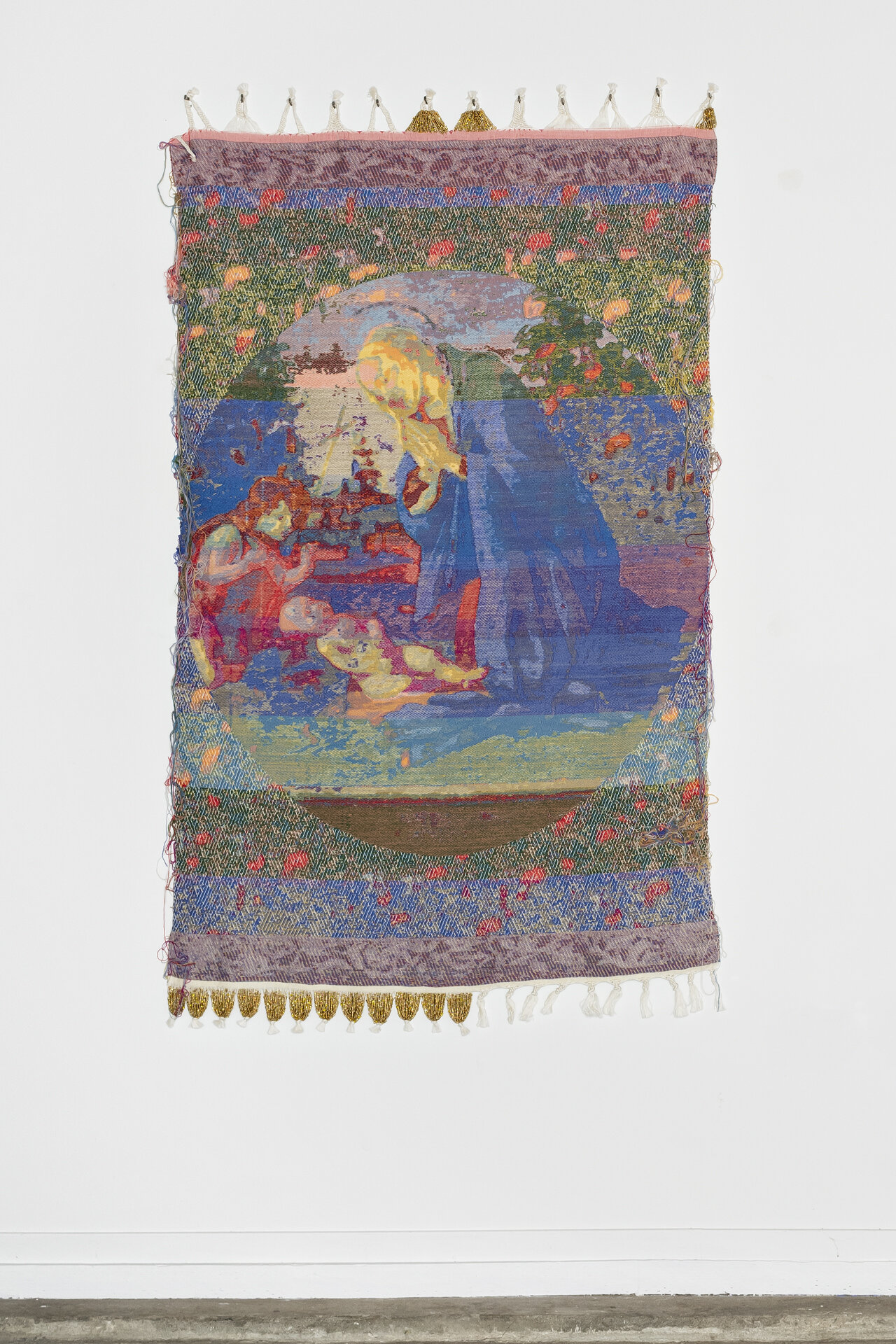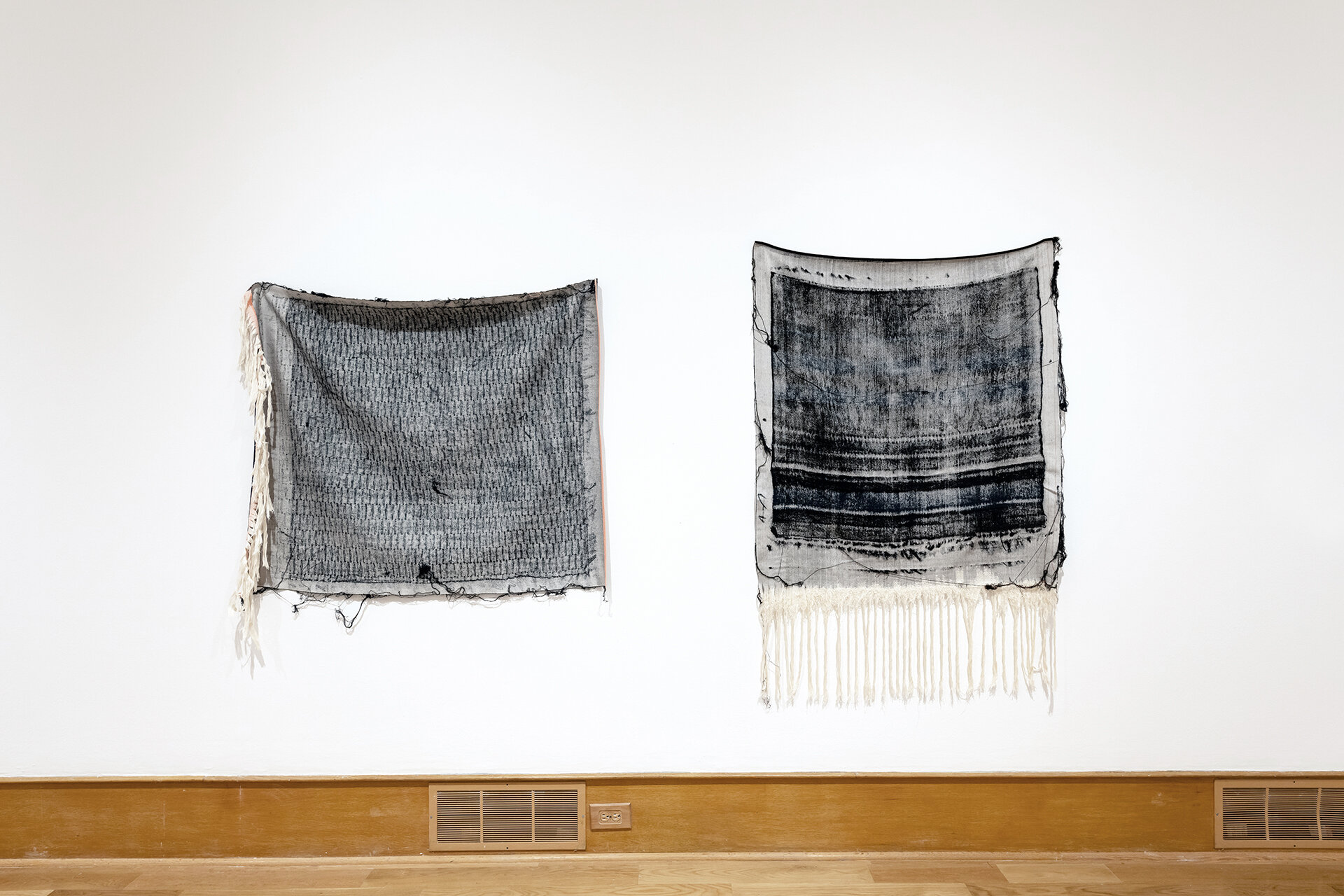Transdisciplinary weaver, John Paul Morabito engages Queerness, ethnicity, and the sacred through the medium of tapestry reimagined in the digital age. Their work outputs woven forms, moving images, and performances that look toward a future-past horizon where one can exalt Queer devotion, transcendence, and grace.
Throughout the current crisis, Morabito has been working on a floor loom at home, in Chicago, IL which they acknowledge sits on the traditional homeland of the Peoria, Kaskaskia, Piankashaw, Wea, Miami, Mascoutin, Odawa, Sauk, Mesquaki, Kickapoo, Potawatomi, Ojibwe, and Chickasaw Nations.
For more information, please see: www.johnpaulmorabito.com and on Instagram @johnpaulmorabito.
John Paul Morabito, Madonna del filatore (dopo Leonardo da Vinci), 2018. Photo courtesy of Ritual of Succession, CULT Aimee Friberg Exhibitions, 2020. Photo credit: Phillip Maisel.
First, and most importantly, how are you doing? How are you navigating the highs and lows?
This is a deeply difficult moment and words do not suffice. I feel very sad for the world and for people I love. Day to day I am stable. I am grateful for that and for the grounding presence of my studio. Despite other precarities, stability during a global pandemic and political uprising is a privilege that comes with responsibility.
It's my experience that most artists engage with some level of self-isolation in their day to day art practice. Has this been your experience? And if so, have you found these innate rhythms to be helpful during this larger, world-wide experience of isolation?
Solitude is a significant part of my life. It’s like a dear, old friend. Queer people are very good at being alone. While the idea of Queer sociality gets a lot of focus, Queerness is inextricably linked to isolation. Simply put, ostracization teaches you how to be alone. My practice is bound up in Queer solitude; I’m interested in a vision of grace offered through isolation and sorrow (wow that’s Catholic…). This is mirrored in studio activity rooted in slow, methodical making that requires many hours of solitude. Beyond this procedural reality, I need to simply be with the work. A dialogue between myself, matter, and form happens when I am alone, and I need that to drive the work forward. This is when those pathways to places yet unknow reveal themselves.
John Paul Morabito, Madonna adorante il bambino con il bambino San Giovanni (dopo Sandro Botticelli), 2018. Photo courtesy of Ritual of Succession, CULT Aimee Friberg Exhibitions, 2020. Photo credit: Phillip Maisel.
It would be great if you could briefly talk us through your practice. Understanding it is integral to appreciating the multivalence of your work.
With sincere blasphemy, I employ the fallen glory of tapestry to reorient the holy image within Queer cosmology, temporality, and history. My materials – cotton, wool, synthetic gold, and digital matter – are at once exquisite and contrived, further reflecting the irresolute tensions between Queerness, ethnicity, and the sacred. New worlds are imagined where no resolutions can be made.
I am a transdisciplinary weaver working at the interstices of art making, scholarship, and design. My research, making, and pedagogy consider form-making through the mediated interface of the loom. Material based form-making offers an expansive terrain to reconsider image-making. I explore this intersection through the transmutation of painted, drawn, and photographic images into textile matter. Mine is a hybrid practice integrating the hand and technology in the production of Queer tapestries, video, and live work. I understand the textile as a medium and conceptual apparatus through which ideas embody multiplicity. Historically, textiles have been positioned as adjacent to but outside of art. This, in my understanding, is a Queer orientation. I see textile futurity in this adjacency; it guides my practice.
My work employs exquisite craft and visual decadence to mirror the sincerity of faith with Queer sensibility. In my current project, Magnificat, I remediate Italian Renaissance paintings of the Madonna and Child into digitally woven tapestries.WithMagnificat, I draw upon the work of the great masters to complicate, infiltrate, and reclaim my cultural legacy. As the Queer child of an Italian American immigrant family, the Italian Renaissance is a heritage that represents an orthodoxy from which I have been ostracized. Italian people have been Catholic for 2000 years; it is a bond I cannot and will not deny. Responding aesthetically, I activate divested allusions to Catholic opulence within the woven image and extend it beyond the picture plane. Magnificatengages a Queer relationship with time, one that sees the future horizon through a Queer (re)imagining of the past in the present.
John Paul Morabito, La Madonna dei Tempi (dopo Raffaello Sanzio da Urbino), 2019. Photo credit: Ian Vecchiotti.
Has any of your imagery shifted in a reflection to what's currently happening? And why, or why not?
As an artist, it is my responsibility to bear witness to the humanity of contemporary experience through my making. This must be filtered through the context of the immediate moment; a pandemic-induced global shut-down. Time feels unbound as temporalities bleed into one another. I write these words as a Queer, Non-binary, Gay person born during the early years of the AIDS crisis. While I was too young to have been on the front lines, I came of age and into my Queerness in the shadow of a plague. Since the 80’s, HIV and AIDS have defined Queer life (we are still within the epidemic). While there are important differences between the AIDS crisis and the COVID-19 crisis, there are powerful parallels that Queer people feel viscerally. These parallels are driving my making and thinking right now. I want to bear witness to the Queer humanity of this moment.
For a number of years my making has relied on access to the digital jacquard looms where I teach. The COVID-19 summer has interrupted any regularity with which I can access these tools necessitating new directions. In response, I have reintegrated the floor loom as a central tool of the practice. At the loom, color, materiality, and decadence are vocabularies through which I can urge plectogenic abstraction towards Queer form. As I engage these new directions, I find myself thinking of Félix Gonzalez-Torres (particularly the liminal beaded curtains). During the horror that was the AIDS crisis, Gonzalez-Torres bore witness to our Queer humanity. He spun grace and desire into an inseparable form, redirecting the essential carnality of Catholicism into coded representations of the personal and body politic. This is a disruption of the anglo-protestant secularity which dominates contemporary art. I see his work as a Queer and ethnic tangent in which Catholic sensibilities are manifested within conceptual art strategies. As a Queer, Catholic artist working a generation later, my weaving might act as an anachronistic, adjacency that draws sensibilities of Queer conceptual art into the realm of craft.
John Paul Morabito, Frottage 037 and 068, 2016 and 2018. Photo courtesy of Queer Abstraction, Des Moines Art Center, 2019. Photo credit: Rich Sanders, Des Moines.
Are you thinking differently? Coping differently? Inspired differently?
Our moment presents a reckoning with centuries of anti-Black racism and violence amidst a global pandemic. The two are not unrelated. White people and people with white skin have a responsibility to interrogate our privileges, relationships, and positions. This is a watershed moment which we all have a duty to respond to. On the subject of anti-Blackness, I feel it is important for me to step aside so that other voices are heard. Stepping aside doesn’t mean inaction. I’ve chosen to donate artwork towards fundraising efforts for Black-led organizations such as Campaign Zero, Color of Change, and Black Trans Advocacy. I’ve been doing this individually via Instagram and with CULT | Aimee Friberg Exhibitions in San Francisco. Seeing this kind of action from artists and independent galleries is encouraging; our powerful institutions need to follow that lead.
I am a teacher, and I feel it is an absolute requirement to engage the crisis through my position in the academy. The lineage of weaving handed down through Modernism is bound up in coloniality and it is important that I wrestle with that directly in the classroom. Fiber, as a discipline, upholds cishetero white supremacy. It is therefore urgent that textiles embrace fluid perspectives which make room for people and ideas situated along the periphery. Through my teaching I work to highlight a longer and more inclusive history in which Black and Brown folks, Indigenous makers, Womxn, the Queer community, and others have impacted the development of aesthetics. Now is a time to change not only what we teach, but howwe teach. COVID-19 has initiated a complete restructuring of pedagogy. This has me asking how that very structure can be equitable. If technology frees us from event-based content delivery, then it will allow us to build a flexible classroom environment to accommodate our students holistically. Leaving behind banking models of education is long overdue; we need to re-envision a collective learning space that values the life experience of each student. We must make space to bear witness to what is happening and give room for mourning that trauma. I want to see learning environments that are dialogic rather than autarchic. If any space can upset the academy and imagine new possibilities it shouldbe the art classroom.
John Paul Morabito, Among the Many, 2019. Photo courtesy of Boundless Encounters: 2019 Hangzhou Triennial of Fiber Art, Zhejiang Art Museum, 2019.
What is bringing you solace, or even joy, in this moment?
Throughout all of this, I am trying to really be in my body and stay grounded in the physicality of breath, pulse, and even touch. Daily yoga helps with this; for a time, everything stops, and I am able to become a body. It’s easy to feel powerless right now but my physicality is something I can control.
What research or writing are you doing that you find compelling?
In addition to the research that comes with university teaching, I have been preparing public lectures for symposia this fall and editing a large project which will be published in the coming year.
Are you reading anything?
I recently began reading The Madonna of 115thStreet: Faith and Community in Italian Harlem, 1880-1950by Robert Orsi. My grandmother grew up on 119thStreet in Harlem, so this book feels especially cathartic.
John Paul Morabito at the loom. Photo credit: Ian Vecchiotti.






